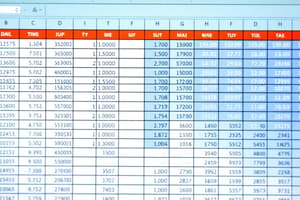Podcast
Questions and Answers
What is the primary purpose of sorting data?
What is the primary purpose of sorting data?
- To facilitate data comparison and analysis
- To identify patterns and trends in the data
- To remove irrelevant data from a dataset
- To arrange data in a specific order based on one or more criteria (correct)
Which of the following is NOT a typical use case for sorting data?
Which of the following is NOT a typical use case for sorting data?
- Arranging a list of names alphabetically
- Organizing numerical data in ascending order
- Removing duplicate entries from a dataset (correct)
- Sorting sales data by date
What is the purpose of filtering data?
What is the purpose of filtering data?
- To rearrange the order of data based on specific criteria
- To display only specific rows of data that meet certain conditions (correct)
- To permanently remove irrelevant data from a dataset
- To identify patterns and trends in the data
Which of the following steps is NOT involved in the process of sorting data in Excel?
Which of the following steps is NOT involved in the process of sorting data in Excel?
In the context of filtering data, what is the purpose of filter toggles?
In the context of filtering data, what is the purpose of filter toggles?
What is the difference between sorting and filtering data?
What is the difference between sorting and filtering data?
Which of the following is an example of a filter condition that could be applied to a dataset?
Which of the following is an example of a filter condition that could be applied to a dataset?
In the process of sorting data in Excel, where do you specify the sorting order (ascending or descending)?
In the process of sorting data in Excel, where do you specify the sorting order (ascending or descending)?
Flashcards are hidden until you start studying




